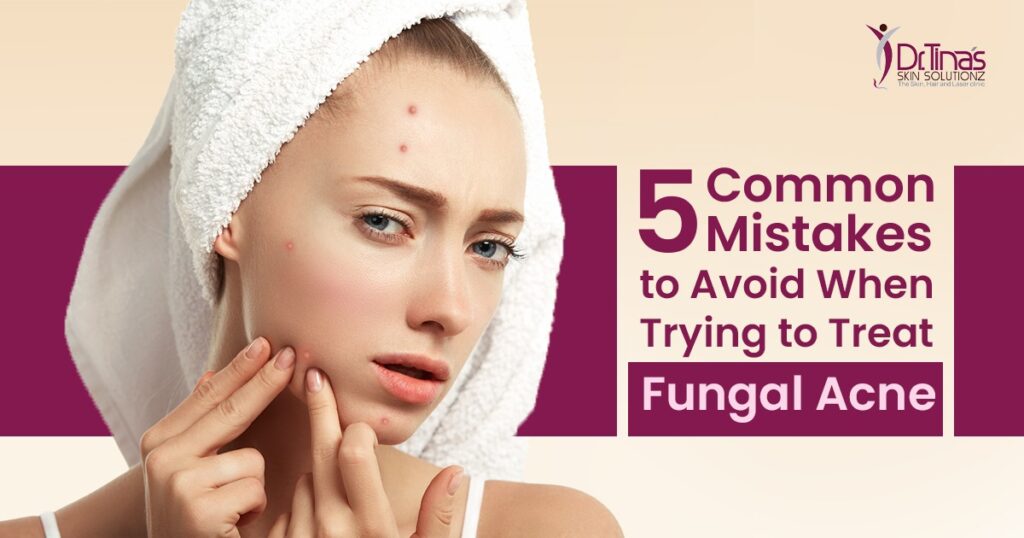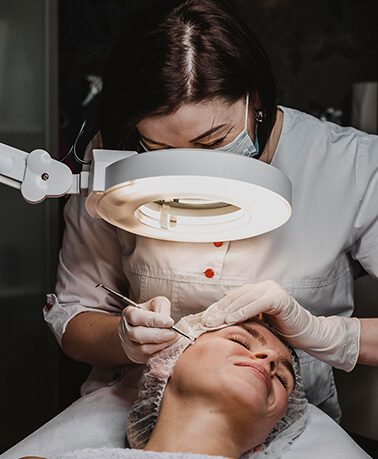5 Common Mistakes to Avoid When Trying to Treat Fungal Acne

Fungal acne, also known as Malassezia folliculitis, is a skin condition that can be both frustrating and confusing.
Unlike regular acne, which is typically caused by bacteria, fungal acne is triggered by an overgrowth of yeast on the skin’s surface.
This yeast, Malassezia, thrives in warm, moist, and oily environments, often causing small, itchy, and inflamed bumps on the skin, particularly on the face, chest, and back.
Though fungal acne may resemble traditional acne, the treatments for the two conditions are vastly different.
Understanding the right approach to fungal acne treatment is crucial for managing the condition effectively. However, many individuals make common mistakes that not only delay the healing process but can also worsen the condition. In this blog, we will explore the top five mistakes to avoid when treating fungal acne and how to address them to achieve the best results.
1. Using Oil-Based Products
One of the primary reasons fungal acne flourishes is its love for oil. Malassezia yeast thrives in oily environments, making oil-based skincare products a poor choice when dealing with fungal acne.
Using moisturizers, sunscreens, or makeup that contain oils or fatty acids can feed the fungi, causing it to proliferate further and worsen the condition.
Mistake: Applying products like moisturizers, sunscreens, or makeup that contain oils or fatty acids.
Solution: To manage fungal acne, opt for non-comedogenic (non-pore-clogging), oil-free, and lightweight formulas that won’t feed the yeast. Look for products that are specifically labeled as suitable for fungal acne treatment, such as those that are free from oils like coconut oil or other fatty acids. Stick with water-based or gel moisturizers and sunscreens, which are less likely to aggravate the condition.
2. Overuse of Harsh Exfoliants
Exfoliation plays a significant role in keeping skin clear by removing dead skin cells and unclogging pores. However, when dealing with fungal acne, it’s essential to be cautious about how often and how aggressively you exfoliate your skin.
Overuse of harsh physical exfoliants can irritate the skin, disrupt its natural barrier, and potentially worsen the fungal overgrowth.
Mistake: Over-exfoliating with physical exfoliants (scrubs or brushes) or aggressive chemical exfoliants.
Solution: Instead of abrasive physical exfoliants, choose gentle chemical exfoliants like AHAs (Alpha Hydroxy Acids) or BHAs (Beta Hydroxy Acids), which are less likely to cause irritation. Lactic acid based creams. These acids can help remove dead skin cells without damaging the skin barrier.
Limit exfoliation to 1-2 times a week, ensuring your skin has time to recover and isn’t further compromised by over-exfoliation.
3. Relying Only on Topical Treatments
Topical antifungal treatments, such as creams and serums, are often effective in controlling fungal acne.
However, relying solely on these treatments without addressing internal factors can limit their effectiveness.
Fungal acne can be triggered by various factors, including poor hygiene, diet, stress, and even tight clothing that traps sweat. Thus, taking a more holistic approach is often necessary for achieving long-term relief.
Mistake: Solely depending on topical antifungals without considering other internal or external factors.
Solution: A comprehensive fungal acne treatment plan should not only include topical treatments like ketoconazole or zinc pyrithione but also consider oral antifungal medications (with a doctor’s recommendation) for more severe cases.
Additionally, maintaining proper hygiene, avoiding tight clothing that traps sweat, and watching your diet (limiting sugar and refined carbs) can help manage the condition more effectively.
Lifestyle changes, such as reducing stress and getting adequate sleep, can also support overall skin health.
4. Ignoring Proper Skincare Routine
One of the most important aspects of managing fungal acne is sticking to a proper skincare routine. Consistency is key, as fungal acne requires gentle and regular care to maintain a balance of healthy skin. Skipping essential steps in your routine, like cleansing or moisturizing, or using harsh, irritating products can lead to more flare-ups and prolonged outbreaks.
Mistake: Skipping essential steps in your skincare routine or using irritating, harsh products.
Solution: Establish a daily skincare routine that includes a gentle, fragrance-free cleanser and a suitable, non-irritating moisturizer.
Cleansing twice a day can help remove excess oil and impurities, while moisturizing keeps the skin hydrated without contributing to fungal growth. Make sure the products you use are designed for sensitive or fungal acne-prone skin to avoid triggering flare-ups.
5. Self-Diagnosing and Incorrect Treatment
Fungal acne is often mistaken for regular acne because of its similar appearance, which can lead to the use of incorrect treatments. Common acne treatments, such as benzoyl peroxide or salicylic acid, are not effective against fungal acne and may even make the problem worse. A lot of people have sensitive acne prone skin.
Applying these treatments can irritate the skin and potentially cause the fungus to grow even more aggressively.
Mistake: Using standard acne treatments that are not suitable for fungal acne.
Solution: The most important step in treating fungal acne is getting a proper diagnosis from a dermatologist. Self-diagnosing and using treatments intended for regular acne may only aggravate the condition. Instead, use treatments specifically formulated for fungal acne, such as antifungal creams containing ketoconazole or zinc pyrithione.
A dermatologist will guide you on the best fungal acne treatment for your skin type and provide personalized recommendations.
Conclusion
Fungal acne can be a persistent and frustrating condition, but understanding the right approach to treatment can make all the difference.
By avoiding common mistakes like using oil-based products, over-exfoliating, relying solely on topical treatments, neglecting a proper skincare routine, and self-diagnosing, you can significantly improve your chances of treating fungal acne effectively.
Remember, a proper diagnosis from a dermatologist and using the appropriate fungal acne treatment products are essential for healing and preventing future flare-ups.
At Dr. Tina’s Skin Solutionz, we emphasize the importance of a comprehensive, gentle, and personalized skincare regimen for managing fungal acne and other skin concerns. Be patient with your treatment journey and remember that clear, healthy skin is possible with the right care.
Seek professional advice, choose the best fungal acne treatment for your skin, and take the time to properly address all factors that may contribute to your condition.
Myths of acne! is acne is not exclusive to oily skin

Dr.Tina Ramachander is one of the best dermatologist in Bangalore and Medical Director at Dr.Tina’s Skin Solutionz, a skin care clinic in Bangalore. She completed her master’s in dermatology from the well acclaimed JJM Medical college in Karnataka and is now a practicising dermatosurgeon and Medical Cosmetologist in Bangalore.

